Our verdict
Pros
- Exceptionally breathable upper
- Ideal cushioning for heel strikers
- Durable Continental outsole
- Excellent foot lockdown
- Comfortable sock-like tongue
- Outstanding performance of Boost in cold temperatures
- Works well as both a running shoe and a casual sneaker
- Recycled materials
Cons
- It's too heavy
- Insufficient cushioning in the forefoot
- Priced at $180, it doesn't quite match its performance
Audience verdict
- Top 29% in running shoes
- Top 30% in neutral running shoes
Comparison
The most similar running shoes compared
+ + Add a shoe | |||||
|---|---|---|---|---|---|
| Audience score | 89 Great! | 83 Good! | 81 Good! | 84 Good! | |
| Price | $180 | $140 | $140 | $75 | |
| Pace | Daily running | Daily running | Daily running | Daily running | |
| Shock absorption | Moderate | - | Low | - | |
| Energy return | High | - | High | - | |
| Traction | - | - | Moderate | - | |
| Arch support | Neutral | Neutral | Neutral | Neutral | |
| Weight lab Weight brand | 11.3 oz / 320g 10.7 oz / 303g | 10.1 oz / 286g 10.4 oz / 295g | 10.8 oz / 305g 10.8 oz / 307g | 11.2 oz / 318g 10.1 oz / 285g | |
| Drop lab Drop brand | 14.2 mm 10.0 mm | 11.6 mm 10.0 mm | 11.5 mm 10.0 mm | 12.9 mm 8.0 mm | |
| Strike pattern | Heel | Heel | Heel | Heel | |
| Size | True to size | True to size | True to size | True to size | |
| Midsole softness | Soft | Soft | Soft | Balanced | |
| Difference in midsole softness in cold | Small | Normal | Small | Normal | |
| Toebox durability | Bad | Bad | Decent | Bad | |
| Heel padding durability | Decent | Good | Good | Bad | |
| Outsole durability | Good | Decent | Good | Decent | |
| Breathability | Breathable | Breathable | Breathable | Moderate | |
| Width / fit | Narrow | Medium | Medium | Medium | |
| Toebox width | Medium | Medium | Wide | Medium | |
| Stiffness | Moderate | Stiff | Flexible | Moderate | |
| Torsional rigidity | Flexible | Moderate | Flexible | Moderate | |
| Heel counter stiffness | Moderate | Stiff | Stiff | Flexible | |
| Heel lab Heel brand | 34.4 mm 22.0 mm | 33.6 mm 34.0 mm | 27.6 mm 22.0 mm | 31.9 mm 34.0 mm | |
| Forefoot lab Forefoot brand | 20.2 mm 12.0 mm | 22.0 mm 24.0 mm | 16.1 mm 12.0 mm | 19.0 mm 26.0 mm | |
| Widths available | NormalX-Wide | Normal | NormalWide | NormalWide | |
| Orthotic friendly | ✓ | ✓ | ✓ | ✓ | |
| Season | SummerAll seasons | SummerAll seasons | SummerAll seasons | All seasons | |
| Removable insole | ✓ | ✓ | ✓ | ✓ | |
| Ranking | #187 Top 29% | #268 Bottom 27% | #294 Bottom 20% | #234 Bottom 37% | |
| Popularity | #638 Bottom 3% | #160 Top 44% | #261 Bottom 29% | #318 Bottom 14% |
Who should buy
In our opinion, the Adidas Ultraboost is an ideal choice if:
- You're seeking a breathable shoe that can double as a magnificent casual sneaker.
- You desire a durable daily trainer and the extra weight is not an issue.
- The $180 price tag is not a problem.
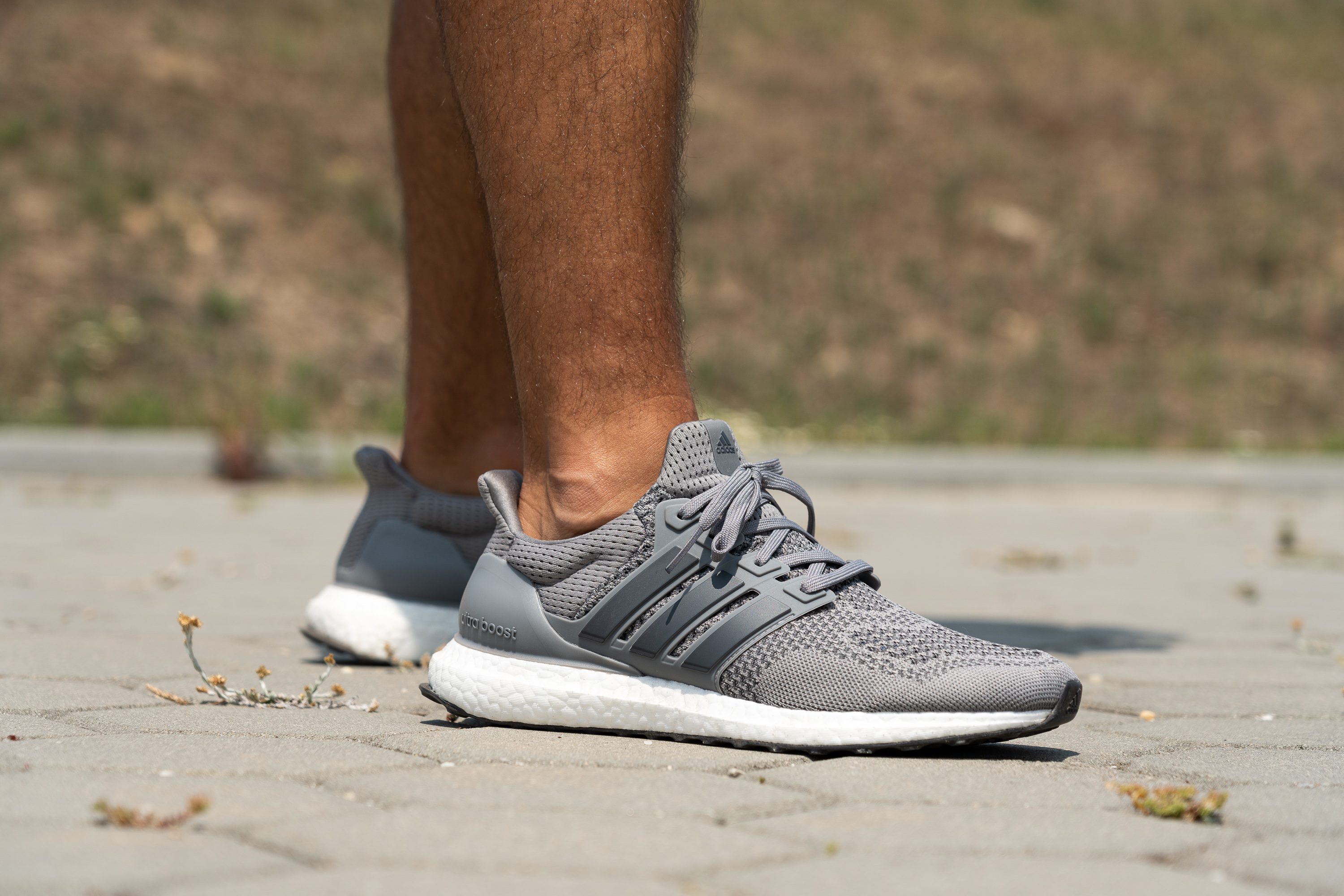
Who should NOT buy
We've concluded that for dedicated runners clocking high mileage, the Ultraboost may not meet contemporary expectations for a high-performance running shoe. In our experience, it's too heavy, lacks energy return, and we think it's priced excessively for the value it offers.
If you want a modern-day, cloud-like daily trainer, we recommend considering options like such as the Nike Invincible 3, which features a bouncy Pebax-based ZoomX midsole, or the ASICS Nimbus 25 with its ultra-cushioned FF Blast+ foam.
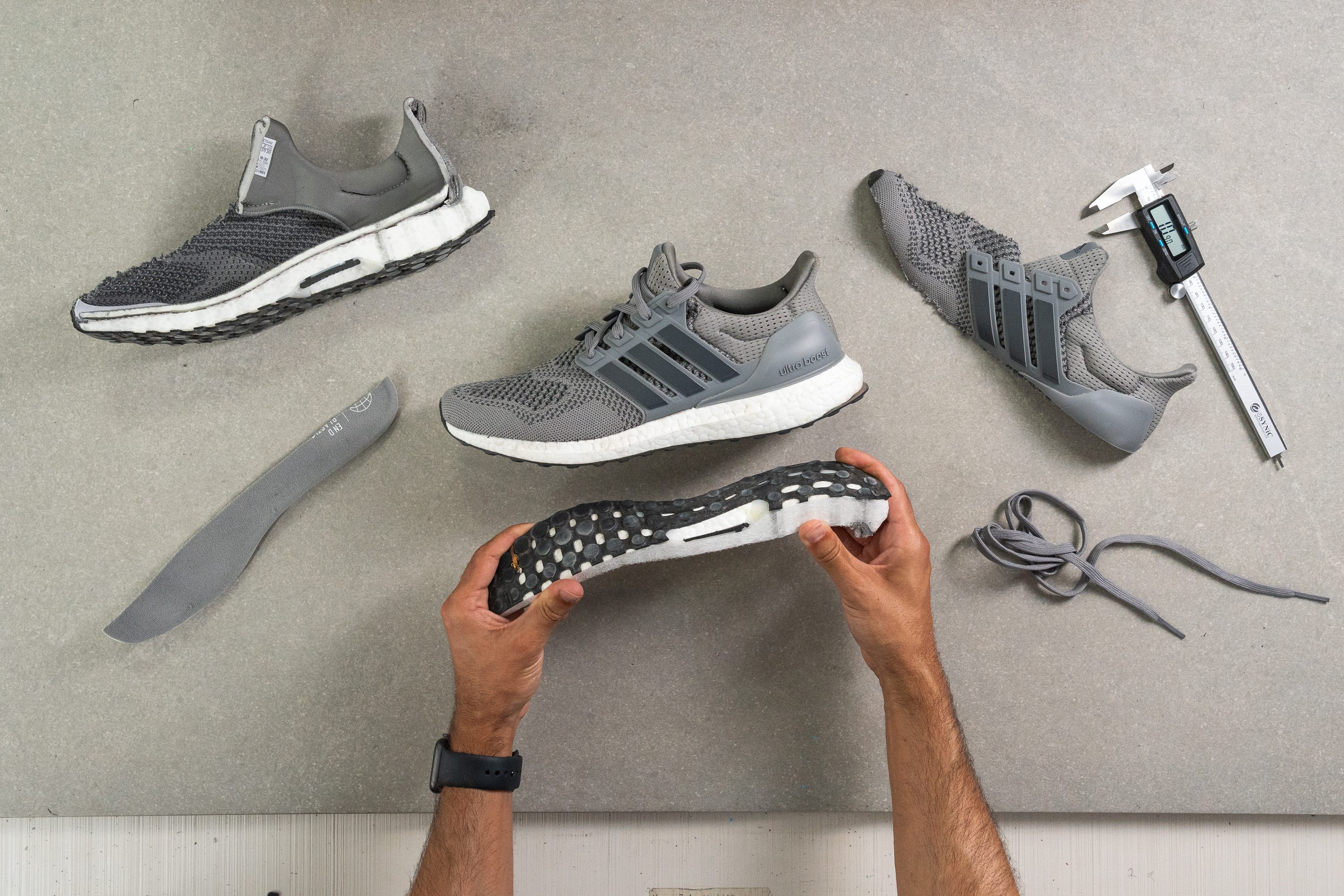
Lastly, if you're a forefoot striker, the Ultraboost might not be your best choice. We suggest you consider the New Balance Fresh Foam X More v4 instead.
Cushioning
Shock absorption
The Ultraboost 1.0 is clearly designed with heel strikers in mind, offering 122 SA of shock absorption in the heel. In contrast, the forefoot comes in noticeably lower at just 89 SA.
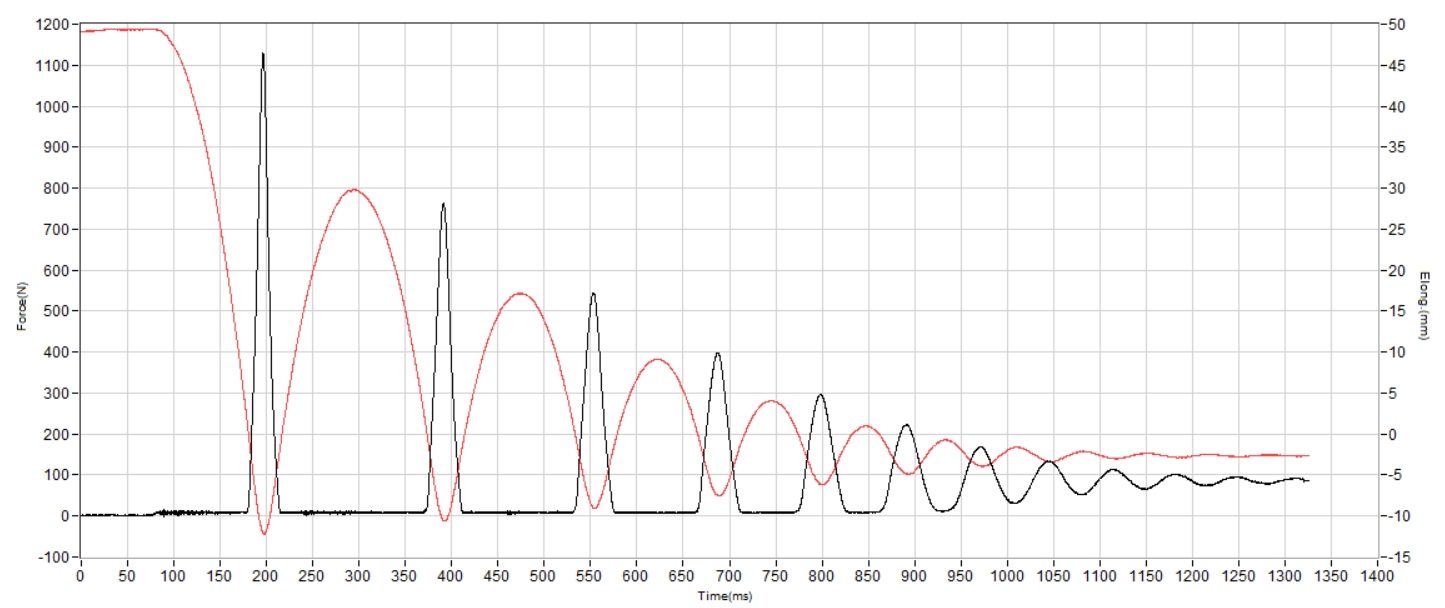
| Ultraboost 1.0 | 122 SA |
| Average | 129 SA |
Energy return
We tested this shoe using the ASTM F1976 procedure and recorded a dynamic 66.9% energy return. That easily outperforms most daily trainers on the market and justifies the premium price Adidas usually asks for the Boost foam.
| Ultraboost 1.0 | 66.9% |
| Average | 58.5% |
Heel stack
With a generous 34.4 mm of height, this shoe is certainly a top pick for heel strikers. In fact, it's this feature that has made it a crowd favorite across all the Ultraboost editions.
It's worth noting that our measurement exceeded Adidas's official 22mm mark by over 12mm, which is insane. This discrepancy is due to the Ultraboost's initial launch before the World Athletics guidelines for measuring drop—which we adhere to strictly in the lab.
These guidelines stipulate that stack height should be measured inclusive of the insole and outsole and on the same point in every shoe. Adidas, however, measured only the foam and used a different reference point.
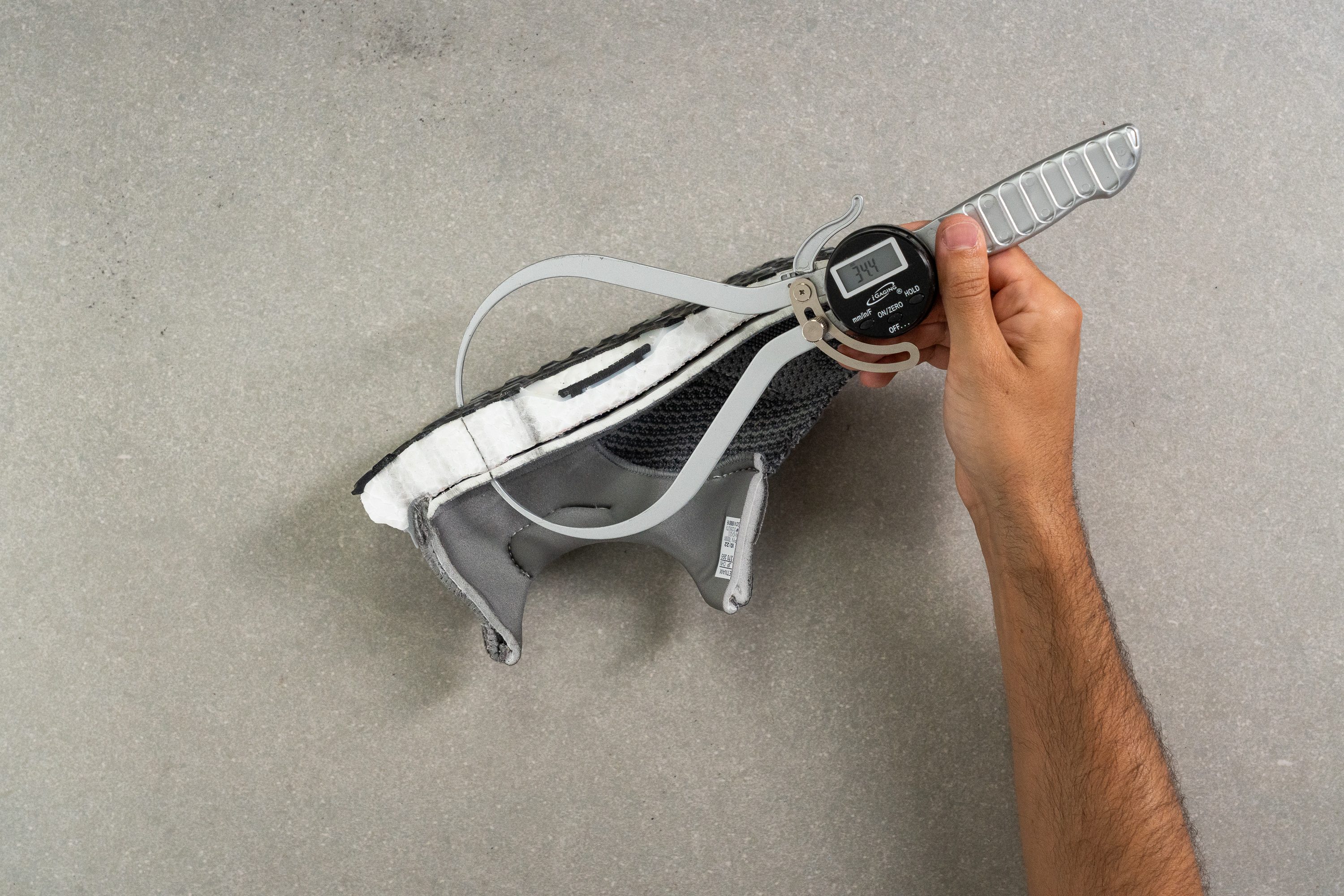
| Ultraboost 1.0 | 34.4 mm |
| Average | 34.8 mm |
Forefoot stack
On the other hand, for those of us who predominantly strike with the midfoot or forefoot when running, this might not be a top road running shoe despite its $180 price tag.
The caliper-based measurement comes in at just over 20.2 mm, which, to be frank, feels really low. It's a big head-scratcher, especially considering that this shoe is often marketed as a go-to for long-distance running. No way, Adidas!
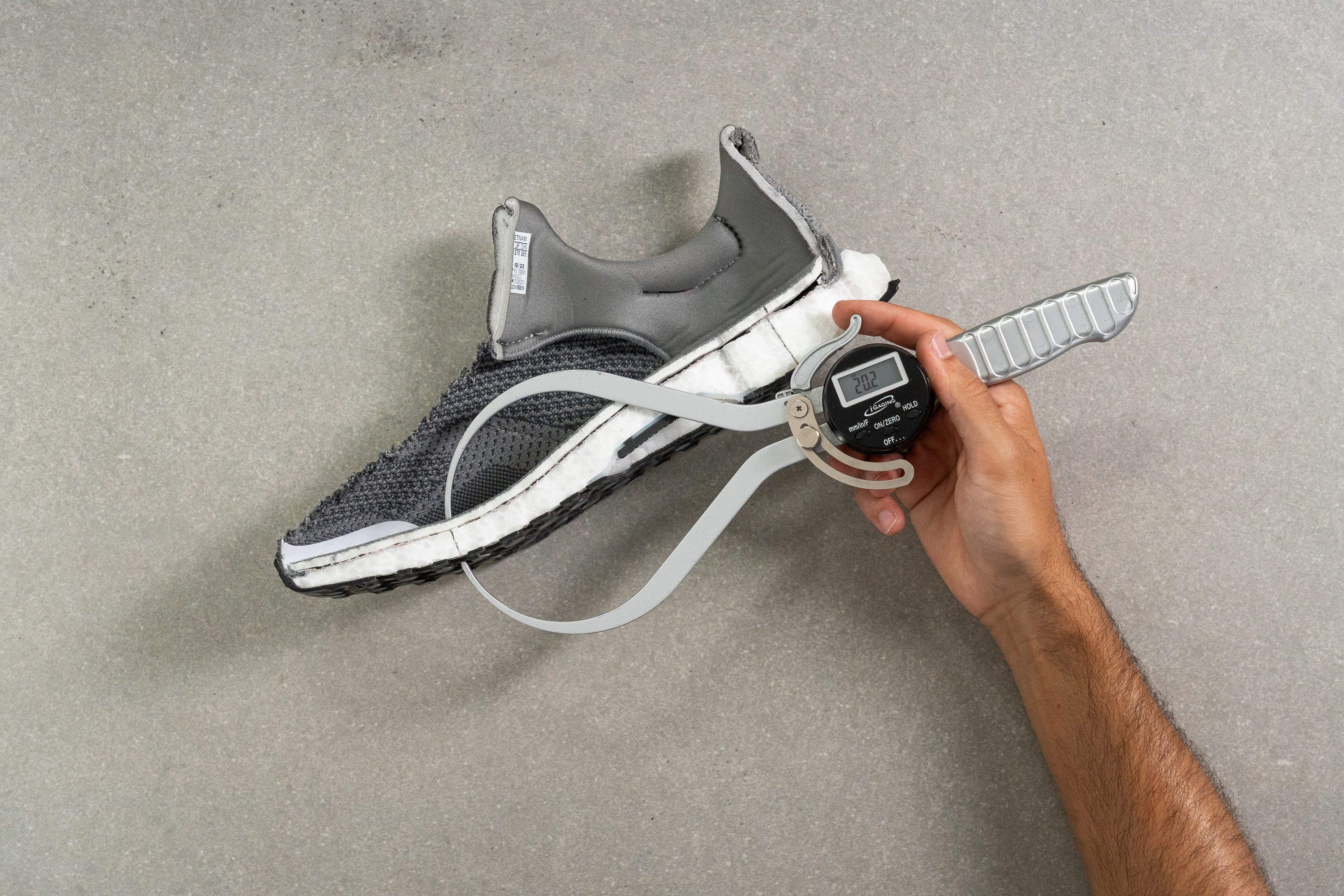
| Ultraboost 1.0 | 20.2 mm |
| Average | 26.2 mm |
Drop
Both measurements translate to a staggering 14.2-mm heel-to-toe drop, a jaw-dropping result that counts among the steepest we've ever logged in our lab.
It's fantastic news for heel strikers. However, it's an awful drop for those who tend to be midfoot or forefoot strikers. And it's too far away from the official 10-mm drop stated by Adidas.
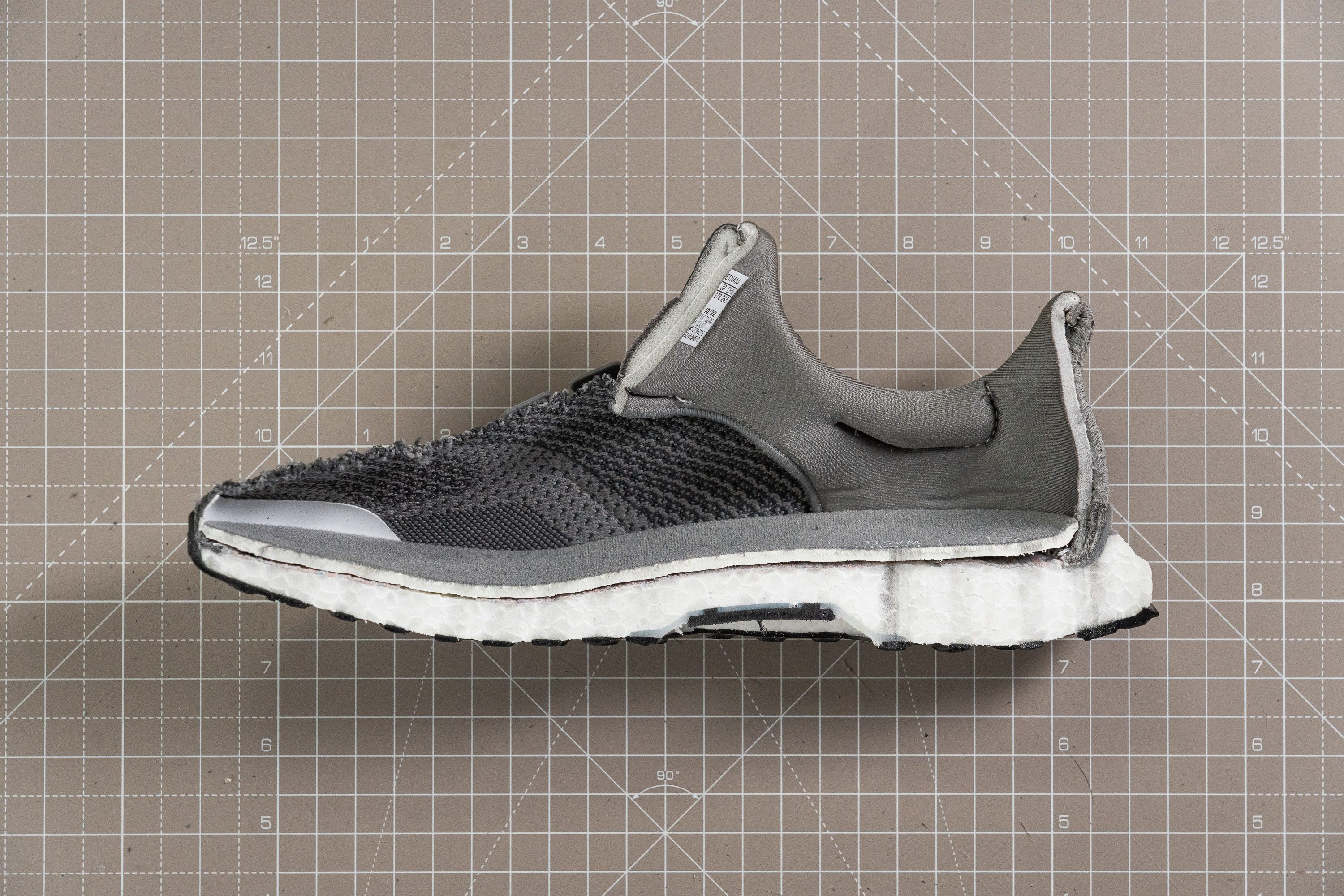
| Ultraboost 1.0 | 14.2 mm |
| Average | 8.6 mm |
Midsole softness
Now, let's talk Boost. Back in 2013, this TPU-based foam took the world by storm with its springiness and dreamy soft feel, as we explained in our advanced guide about foams. And it delivered world records in long distance running.
Yet, a decade later, it's evident that while it's fine for walking or the occasional jog, it doesn't quite make the cut for serious runners.
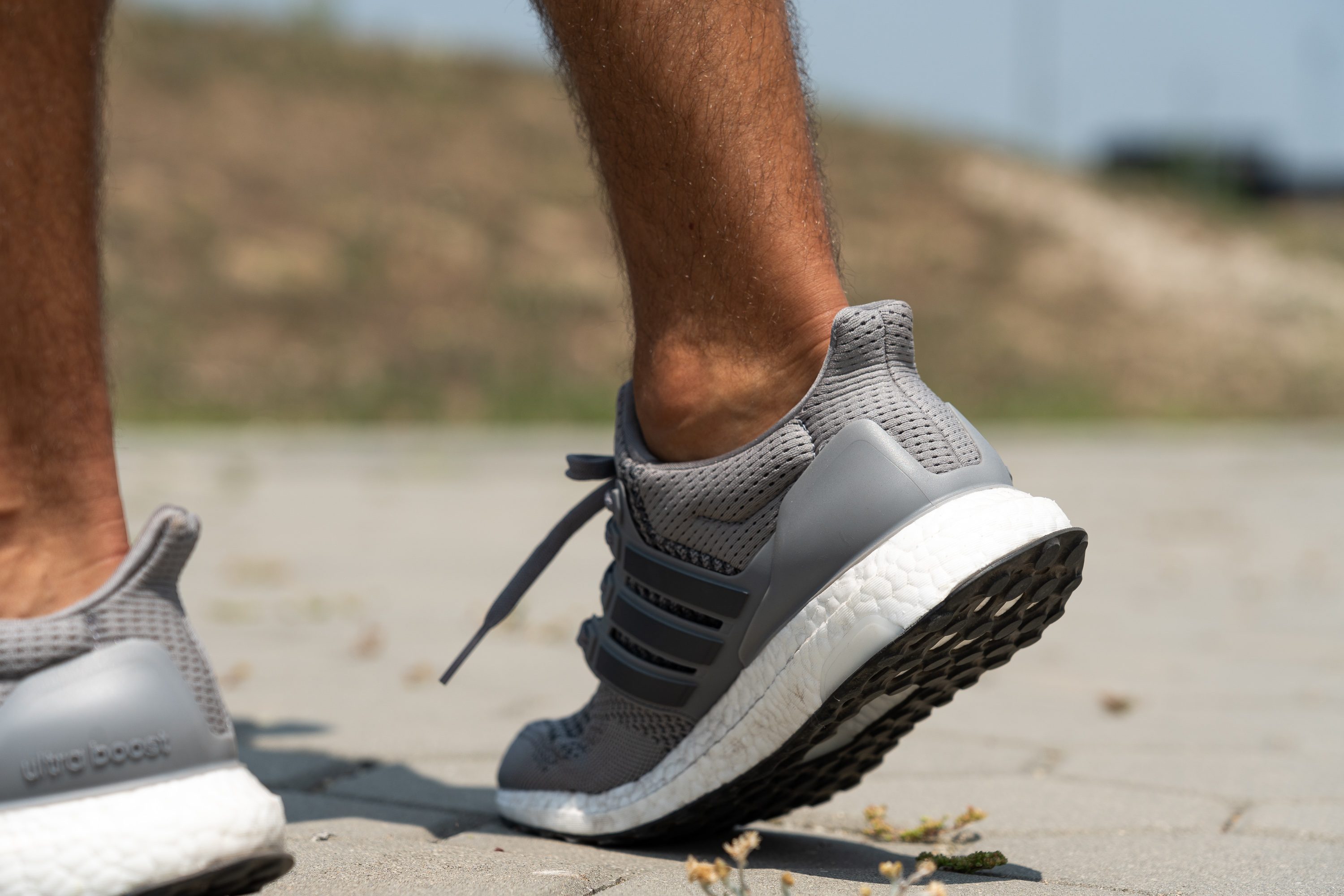
With the advent of superfoams such as ZoomX and Lightstrike Pro, Boost now feels a bit old fashioned. But let's not overlook its durability and its excellent performance for walking and light jogging. That makes it a top-notch shoe for casual runners.
We recorded a measurement of 19.9 HA, indicating that it's softer than your average foam. Yet, we noticed that this plush sensation is more evident during a walk. When you pick up the pace to run, the foam feels a tad firmer than expected, although it's not firm by any means.
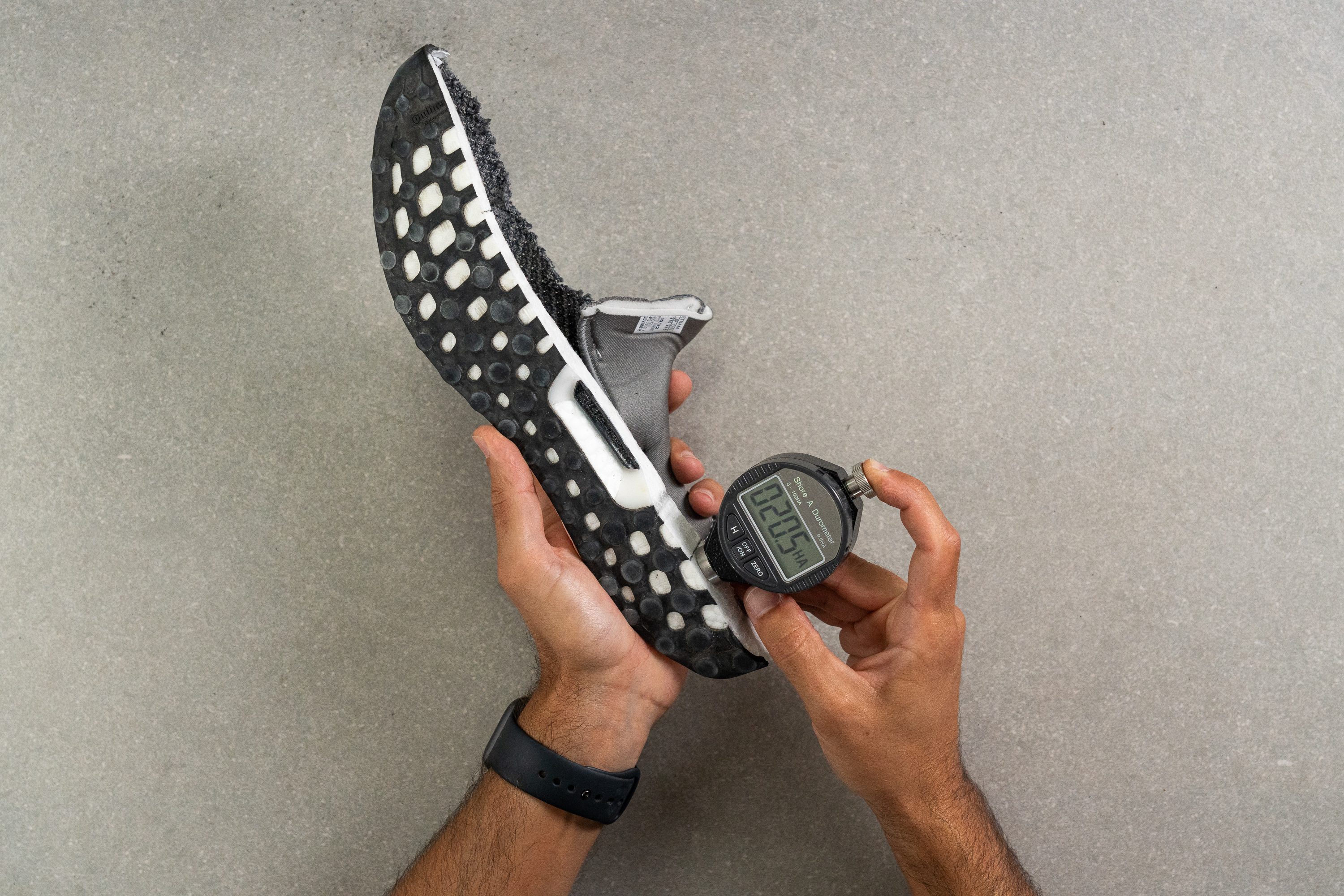
| Ultraboost 1.0 | 19.9 HA |
| Average | 20.4 HA |
Size and fit
Size
Adidas Ultraboost 1.0 fits true to size (160 votes).
Width / Fit
We measured the upper at its widest part, registering a narrower-than-average result: 95.9 mm.
However, here's a crucial point here: the Ultraboost's Primeknit upper is known for its super-stretchy nature, which we showcase in the video below.
After hitting the roads or just walking around in these shoes a few times, we found them really spacious.
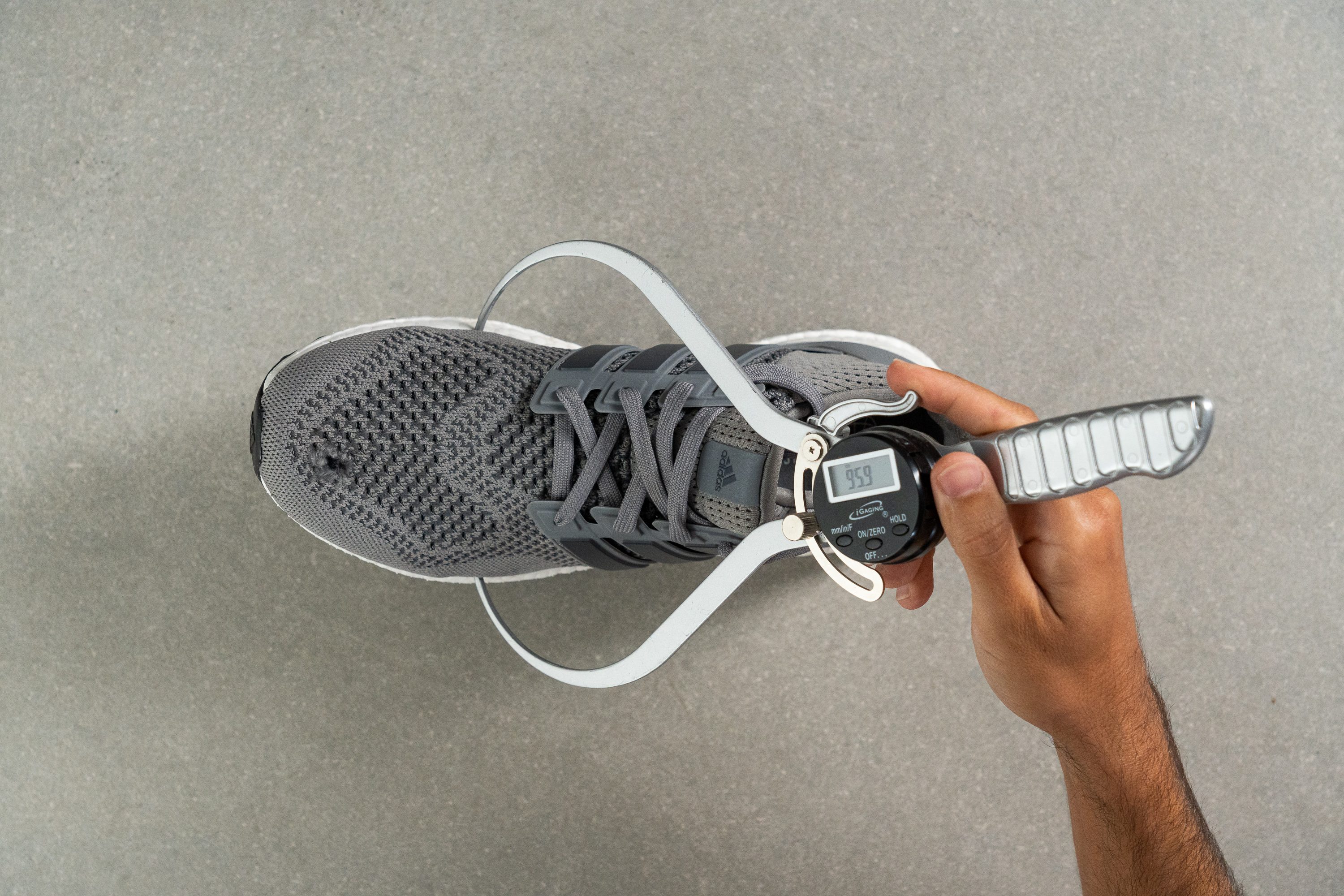
This test follows an older methodology, which is why you don't see recently tested shoes in the chart. Results from different methodologies can not be compared.
| Ultraboost 1.0 | 95.9 mm |
| Average | 98.5 mm |
Toebox width
No worries when it comes to the big toe area—there's loads of space for your toes to wiggle around!

This test follows an older methodology, which is why you don't see recently tested shoes in the chart. Results from different methodologies can not be compared.
| Ultraboost 1.0 | 76.2 mm |
| Average | 78.4 mm |
Flexibility / Stiffness
This is just the opposite of the super-rigid carbon-plated shoes like the Nike Alphafly 2. In fact, it took just a 10.1N force for us to bend it to 90 degrees.
This places it among the top 2% of the most flexible shoes we've examined in our lab.
This test follows an older methodology, which is why you don't see recently tested shoes in the chart. Results from different methodologies can not be compared.
| Ultraboost 1.0 | 10.1N |
| Average | 28.1N |
Stiffness in cold (%)
Thanks to the TPU-based Boost, it keeps its properties regardless of how freezing it gets outside.
We only had to step up our force—no need for any extra workouts in the gym—to 12.2N to bend it to the measuring point.
That's a 20.3% increase. When you compare it to the average increase of 46.3%, it's clear that we're dealing with a truly world-class performance in this department.
| Ultraboost 1.0 | 20% |
| Average | 33% |
Weight
Weighing in at 11.3 oz (320g), the Ultraboost 1.0 is substantially heavier than the average running shoe. It's a glaring issue in today's world where lightweight footwear is the norm. For instance, another best-seller workhorse like the ASICS Novablast 3 weighs 8.5 oz (242g) and it has a higher stack height.
In summary, while we appreciate the durability and comfort of Boost foam, we can't ignore its tremendous weight. This likely prompted Adidas to introduce the new Ultraboost Light, featuring Boost but in a lighter package.
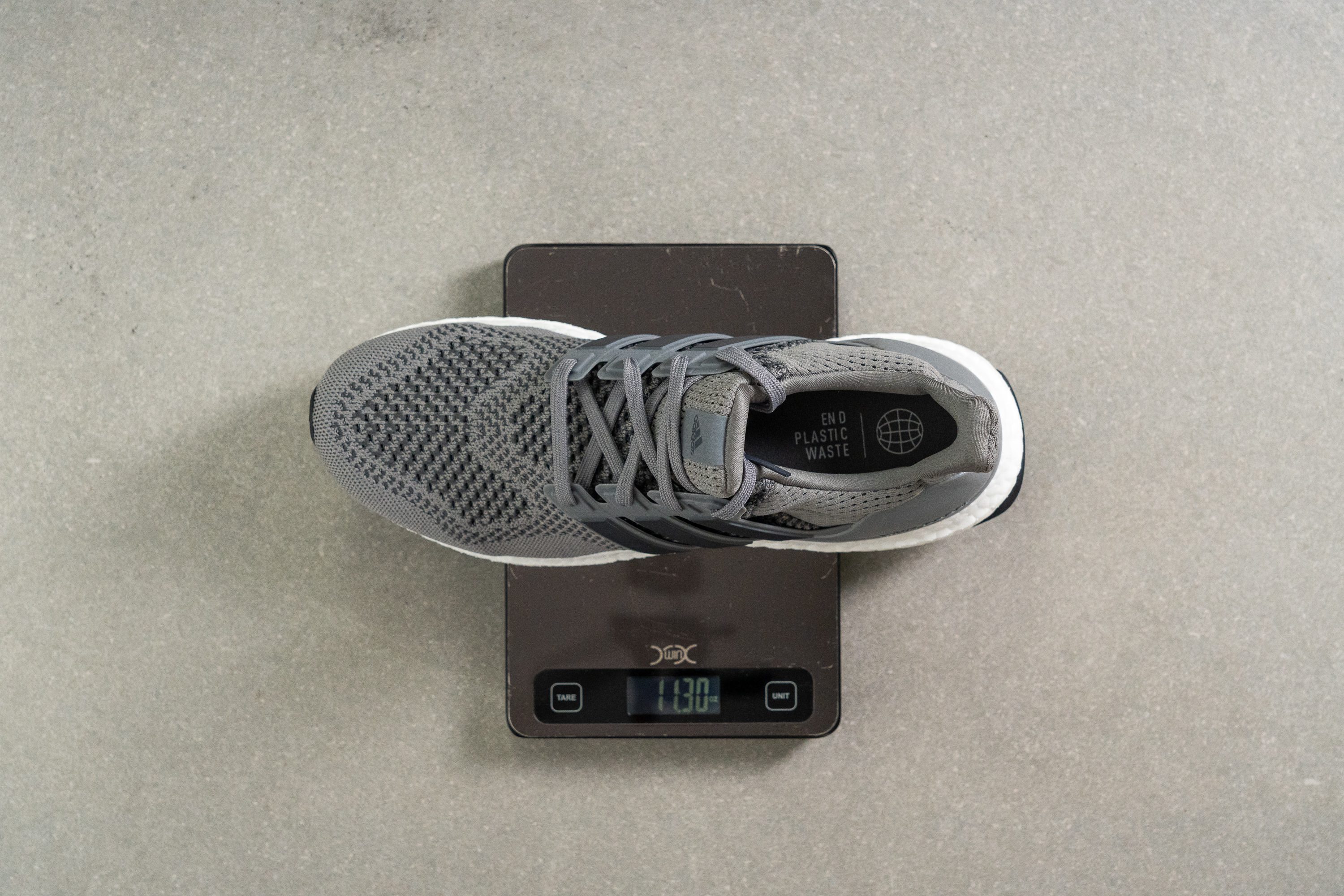
| Ultraboost 1.0 | 11.3 oz (320g) |
| Average | 9.3 oz (264g) |
Breathability
The Ultraboost truly SHINES in breathability, leading the pack with its super-quick smoke expulsion.
We can count on one hand the shoes that outperformed this one in our breathability testing machine, earning it a solid 5/5 rating.
But, what's the secret behind its breathability wizardry? It all comes down to Adidas's smart design of their Primeknit upper. It sports oversized ventilation holes in the toebox and midfoot, which are clearly visible in our light test.
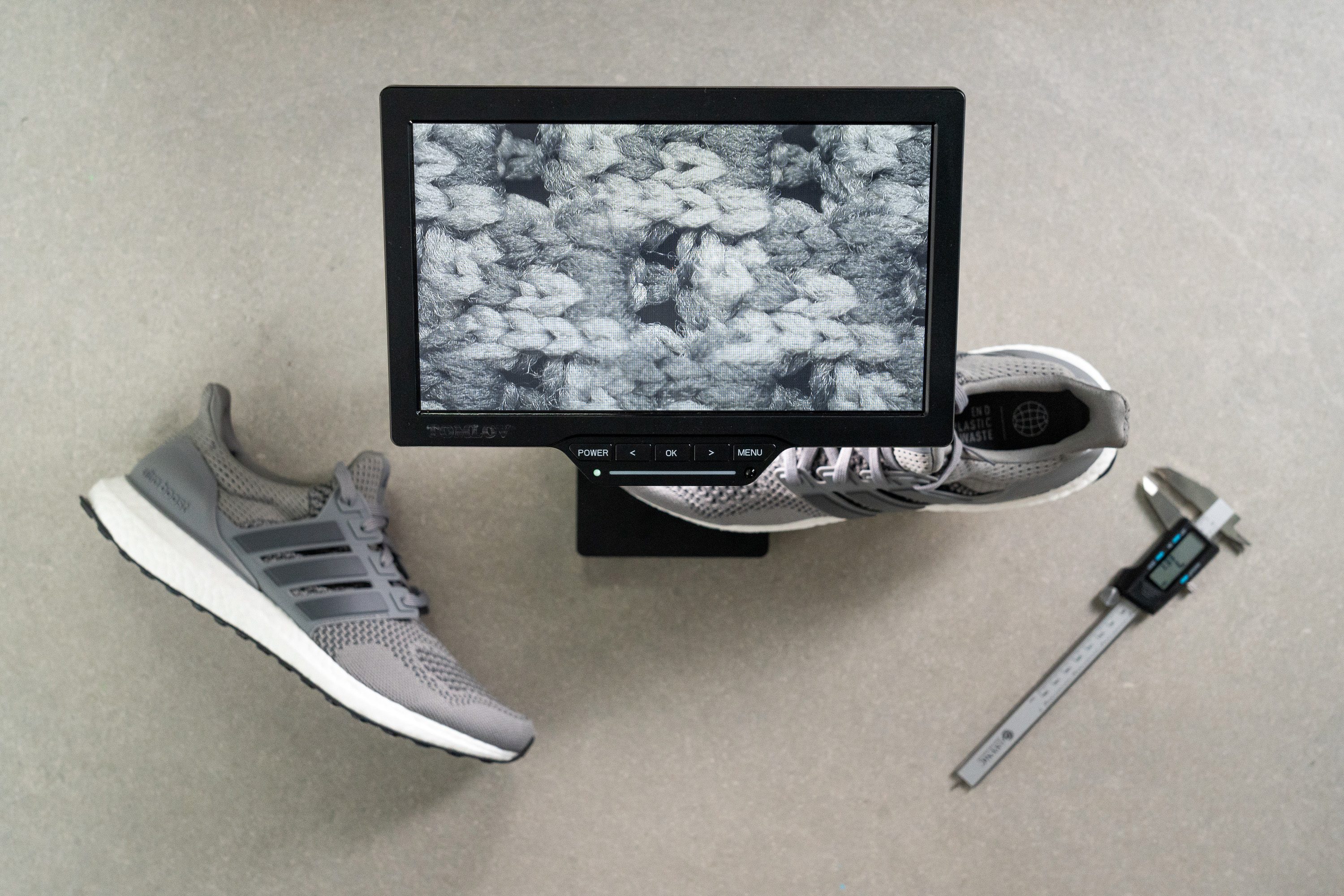
Finally, we turned to our microscope to get a detailed look at those ventilation holes. It reveals a fairly-dense knit pattern interwoven with these larger airflow perforations, working in harmony to achieve perfect breathability.
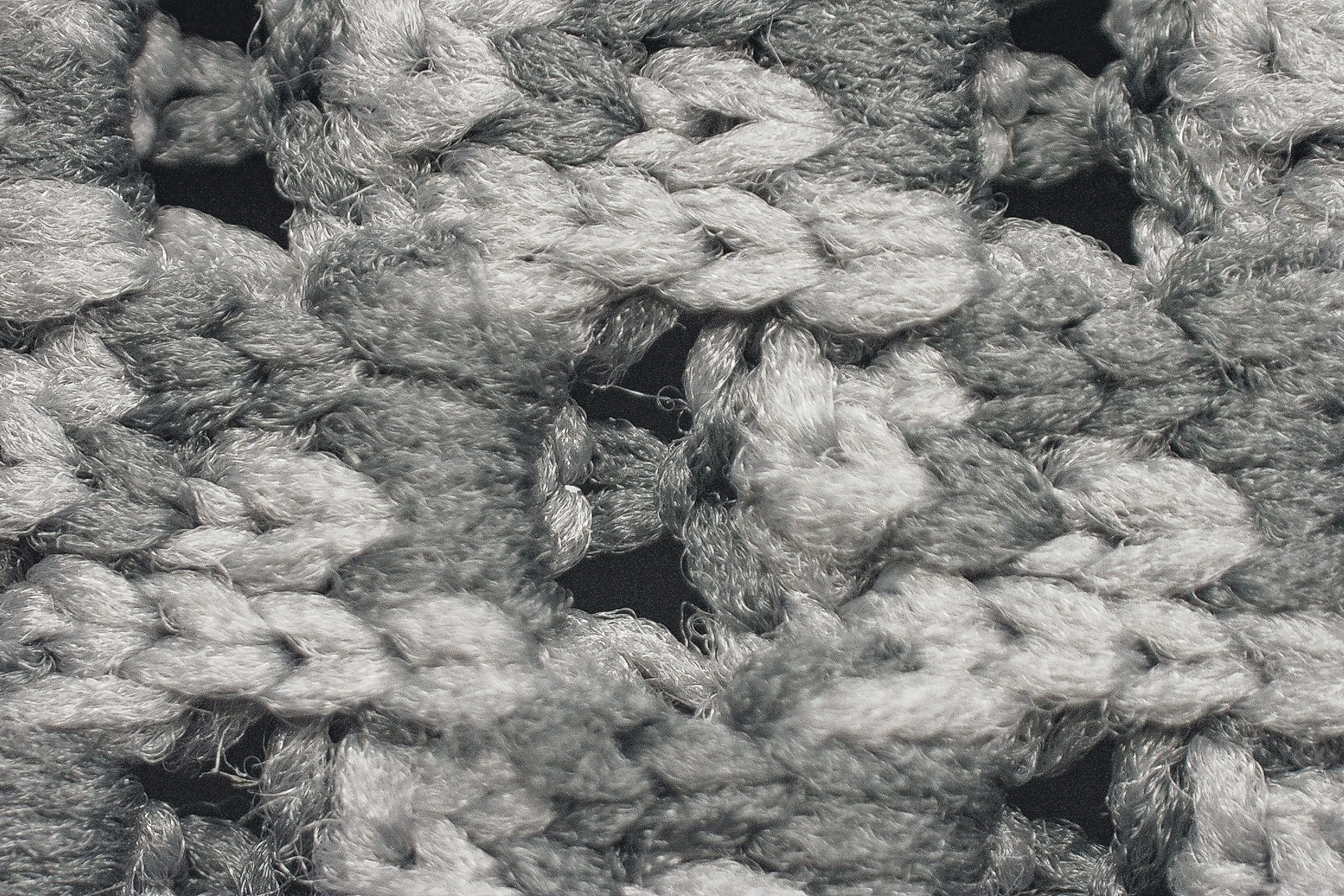
| Ultraboost 1.0 | 5 |
| Average | 3.7 |
Stability
Lateral stability test
Having put the Ultraboost through proper testing, we can't exactly tag it as a "stable" shoe. Still, the plastic-made three-striped midfoot cage—which doubles as a lacing cage—and the heel clip do give neutral runners sufficient stability.
However, if you're someone who needs a more substantial stability feature, it's worth looking into options like the Brooks Adrenaline GTS 22 or the Adidas Adistar 2.0.
Torsional rigidity
The Ultraboost exhibits flexibility akin to a yoga teacher. That's a score of 1 out of 5 on our scale!
We're pretty sure that this shoe's is one of the less rigid we've ever tested. And that's a major reason why we grab it for all-day walking and slow runs.
| Ultraboost 1.0 | 1 |
| Average | 3.5 |
Heel counter stiffness
The Ultraboost doesn't have a traditional heel counter, and this was one of the main innovations that Adidas brought to the table with the original model. Instead, it features two plastic pieces that give the heel some lateral support, and these are what make the heel moderately stiff.
We rated it at 3/5, slightly stiffer than the average, and we're happy to report that we didn't experience any heel slippage, which was a pleasant surprise given the limited lacing options of this shoe.
| Ultraboost 1.0 | 3 |
| Average | 2.9 |
Midsole width - forefoot
With a forefoot width of 107.3 mm, it's clear—one more time—that Adidas has designed this shoe primarily for heel strikers, overlooking the needs of other runners.
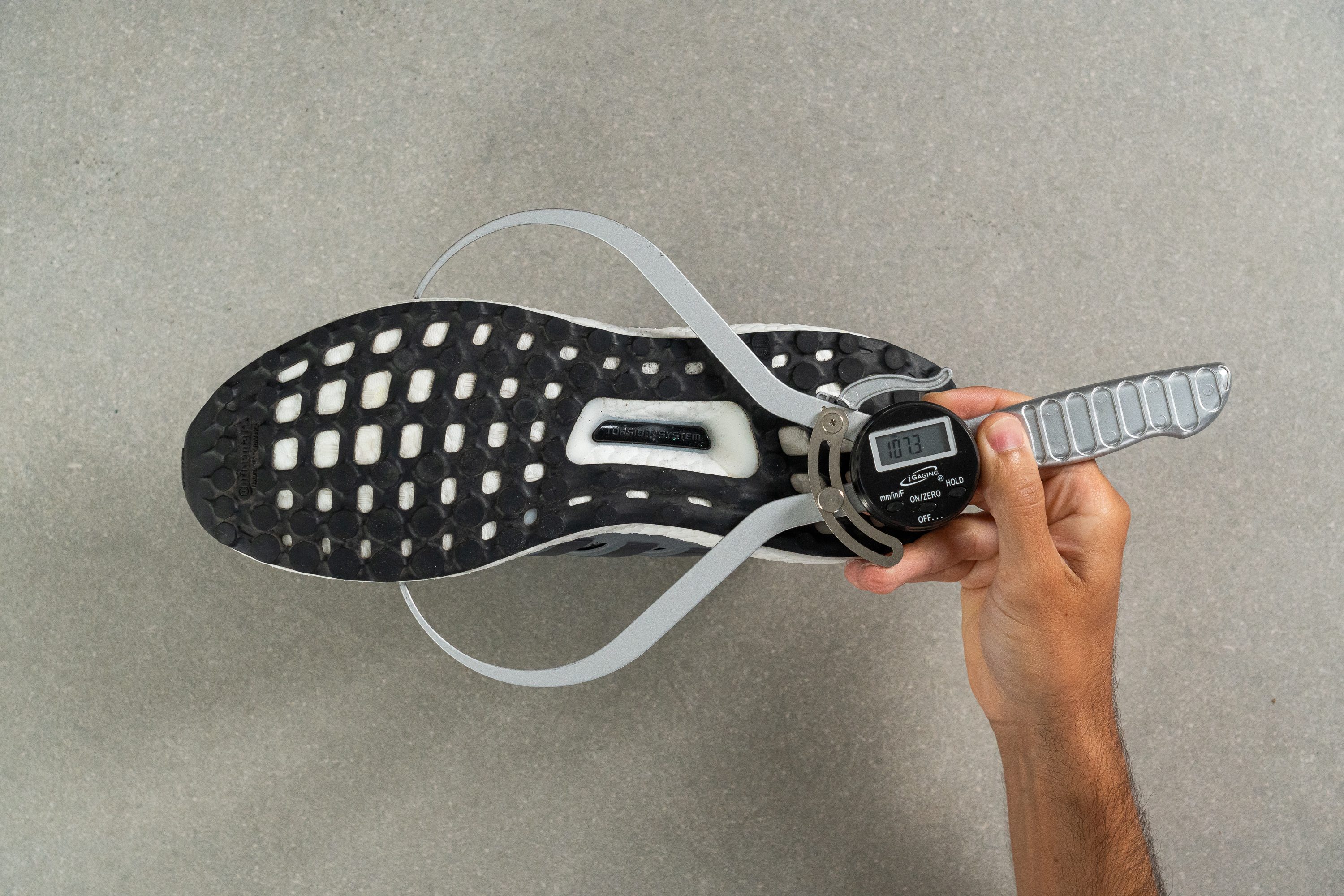
| Ultraboost 1.0 | 107.3 mm |
| Average | 114.4 mm |
Midsole width - heel
This explains why the heel is wider than that of the average shoe. Measuring 91.1 mm, it provides a generous landing zone for runners who predominantly strike the ground with their heels.

| Ultraboost 1.0 | 91.1 mm |
| Average | 90.7 mm |
Durability
Toebox durability
Knit uppers usually come with a trade-off: comfort for durability. The Ultraboost falls into this trap, being unbelievably comfortable yet incredibly fragile.
So it didn't shock us when our standardized Dremel test left the upper destroyed in no time flat and forced us to gave the shoe a 1 out of 5 in this test.
It's just the price you need to pay for its cozyness, and if you tend to wear holes in your shoes with your big toe or pinky toe, you may want to try the Ultraboost 22 or the On Cloudswift 3 instead as they sport a sturdier upper.

| Ultraboost 1.0 | 1 |
| Average | 2.6 |
Heel padding durability
Fortunately, now we have good news! The shoe's heel holds up much stronger against damage compared to the toebox. Our Dremel test acted and we rated it at a satisfying 3 out of 5, surpassing the average shoe's performance.
| Ultraboost 1.0 | 3 |
| Average | 3.4 |
Outsole hardness
A key contributor to the Ultraboost's immense popularity is its legendary Continental outsole. Our measurements placed its outsole hardness at 86.1 HC, which is notably above average.
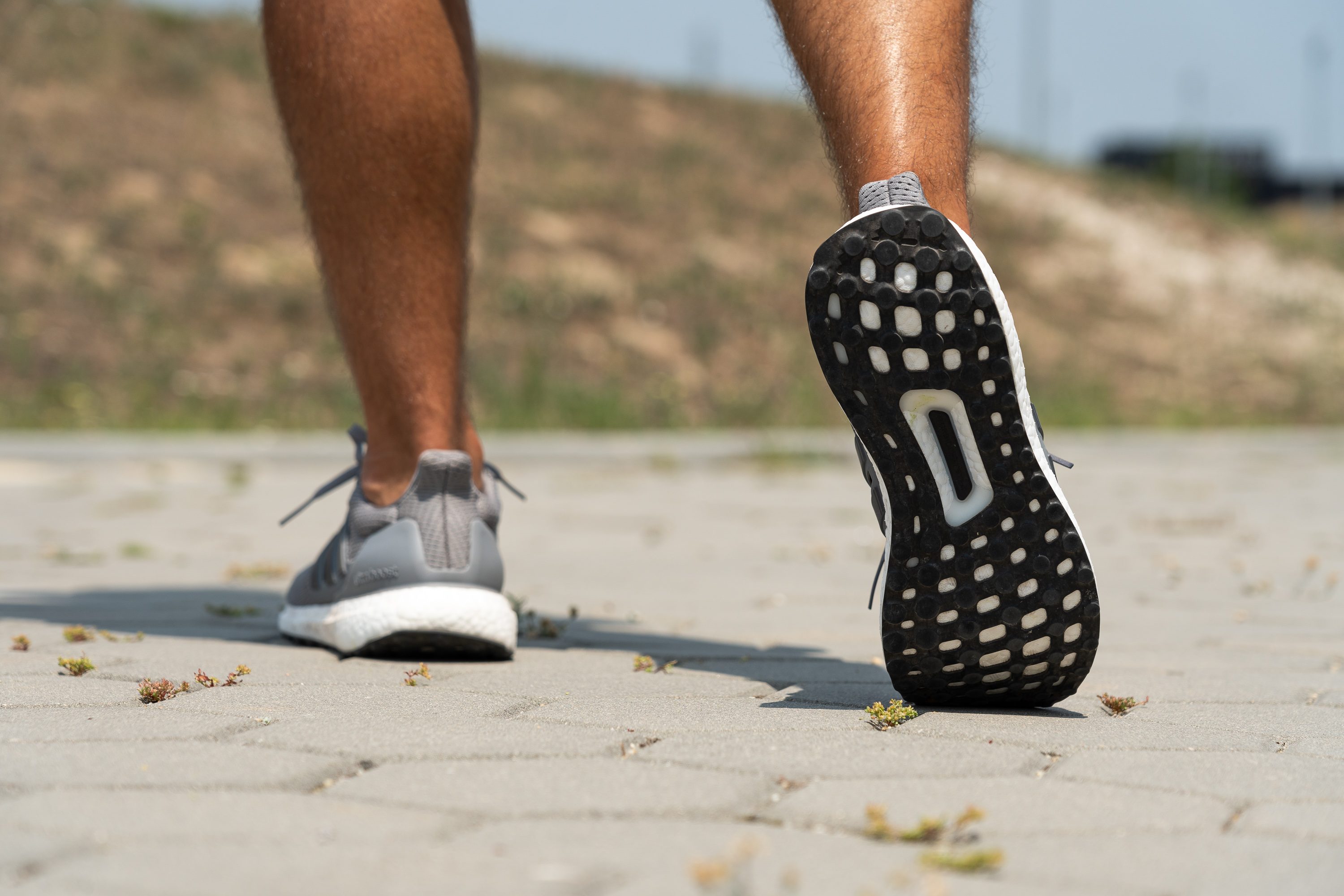
This measurement indicates that the outsole boasts an exceptional, long-lasting durability.

| Ultraboost 1.0 | 86.1 HC |
| Average | 79.2 HC |
Outsole durability
But, there's no better way than to put durability to the real test, right? With the application of 3.2N of force via our Dremel test, we witnessed a mere 0.64 mm of rubber flying away.
This outstanding endurance boost the already high-standing reputation of Continental's performance in Adidas shoes.
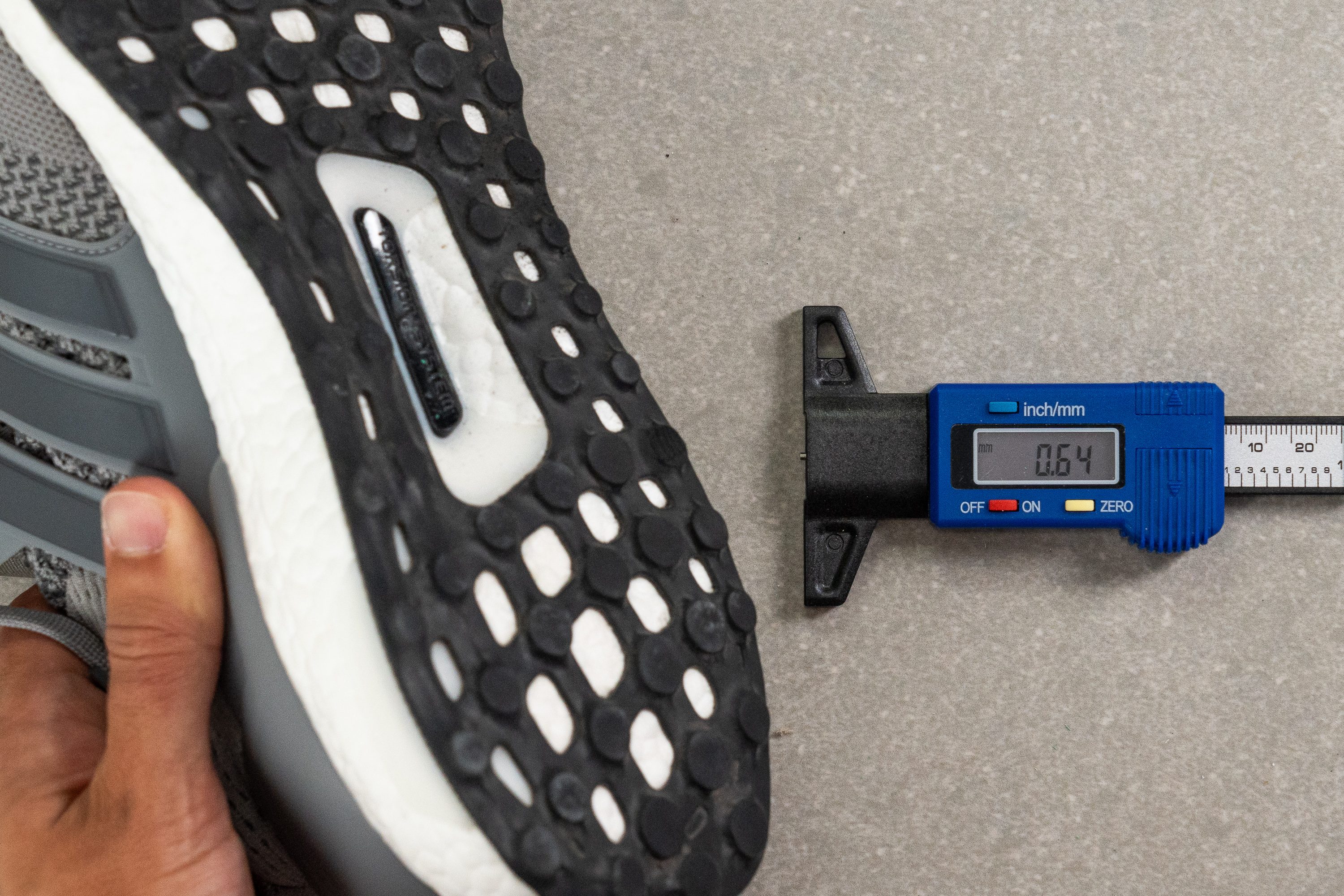
| Ultraboost 1.0 | 0.6 mm |
| Average | 1.1 mm |
Outsole thickness
And we must also factor in the thickness of the outsole. With a whopping 4mm of rubber, we're talking serious mileage with this shoe. Like, not just hundreds, but potentially even thousands of miles until you destroy the rubber.
Without a doubt, the upper is likely to die waaaaay before the outsole.
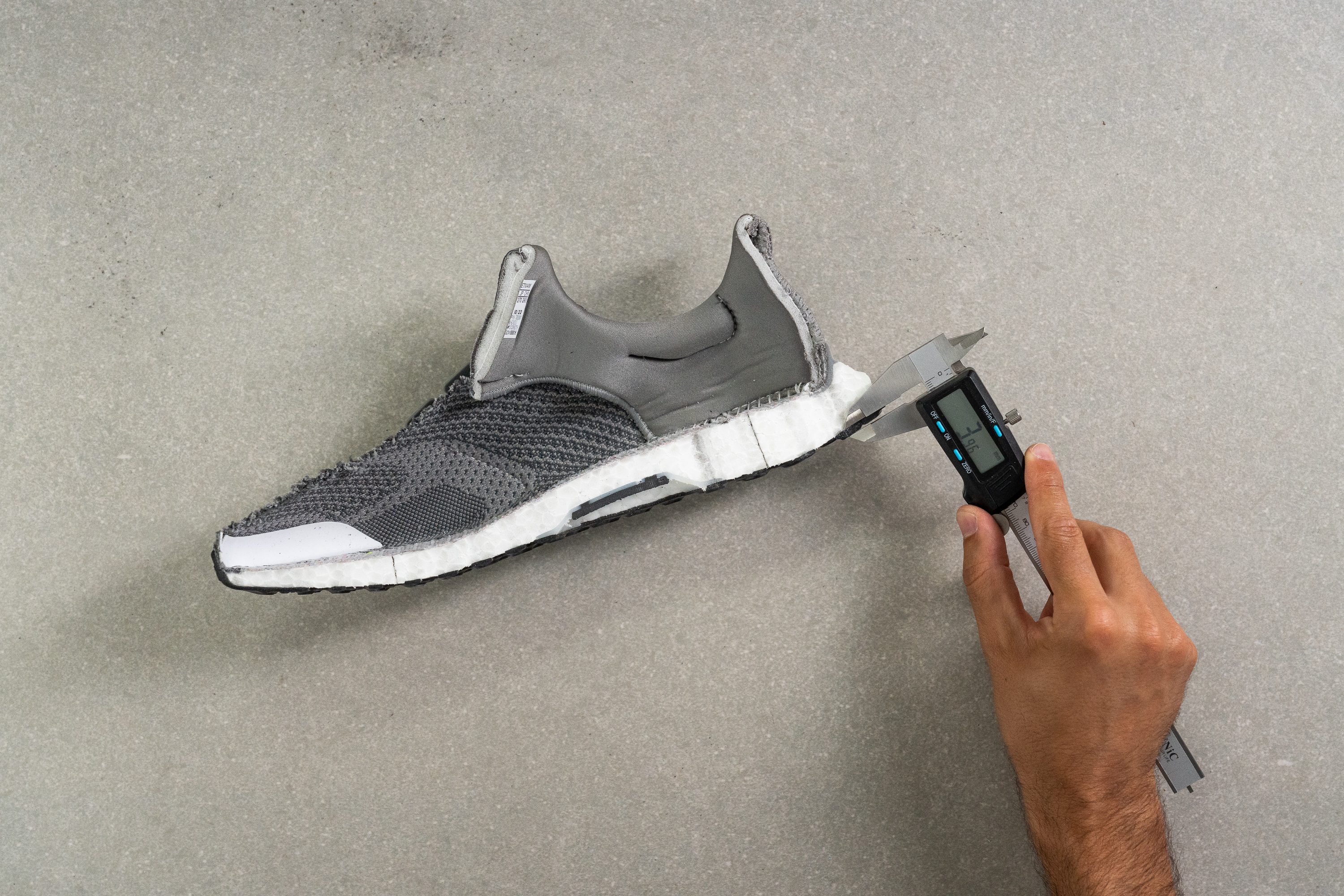
| Ultraboost 1.0 | 4.0 mm |
| Average | 3.2 mm |
Misc
Insole thickness
With a thickness of 3.7 mm, the insole provides ample comfort. We genuinely have no complaints about it despite being thinner than the average.

| Ultraboost 1.0 | 3.7 mm |
| Average | 4.5 mm |
Removable insole
Swapping out the insoles in the Ultraboost is quite a common practice in the sneaker world. And here's a handy tip we can share: if you feel the shoe doesn't offer as much volume as you'd need, you have a couple of options:
- If you're using the shoe solely for casual wear, you can try to remove the insole and see if it feels good.
- If you plan to run in them, consider swapping the original insole for a thinner one. This can give you those few extra millimeters you're after.

| Ultraboost 1.0 | Yes |
Midsole softness in cold (%)
With a measurement of 22.9 HA, the midsole retains a balanced feel in cold temperatures. It's neither too plush nor too firm.
Although Boost might appear a bit dated, its performance in chilly temperatures remains exceptional.
It hardens by only 15.1% in the cold—a result far superior to the average increase of 26.9%. This characteristic ensures an excellent run even in the coldest days of the year.
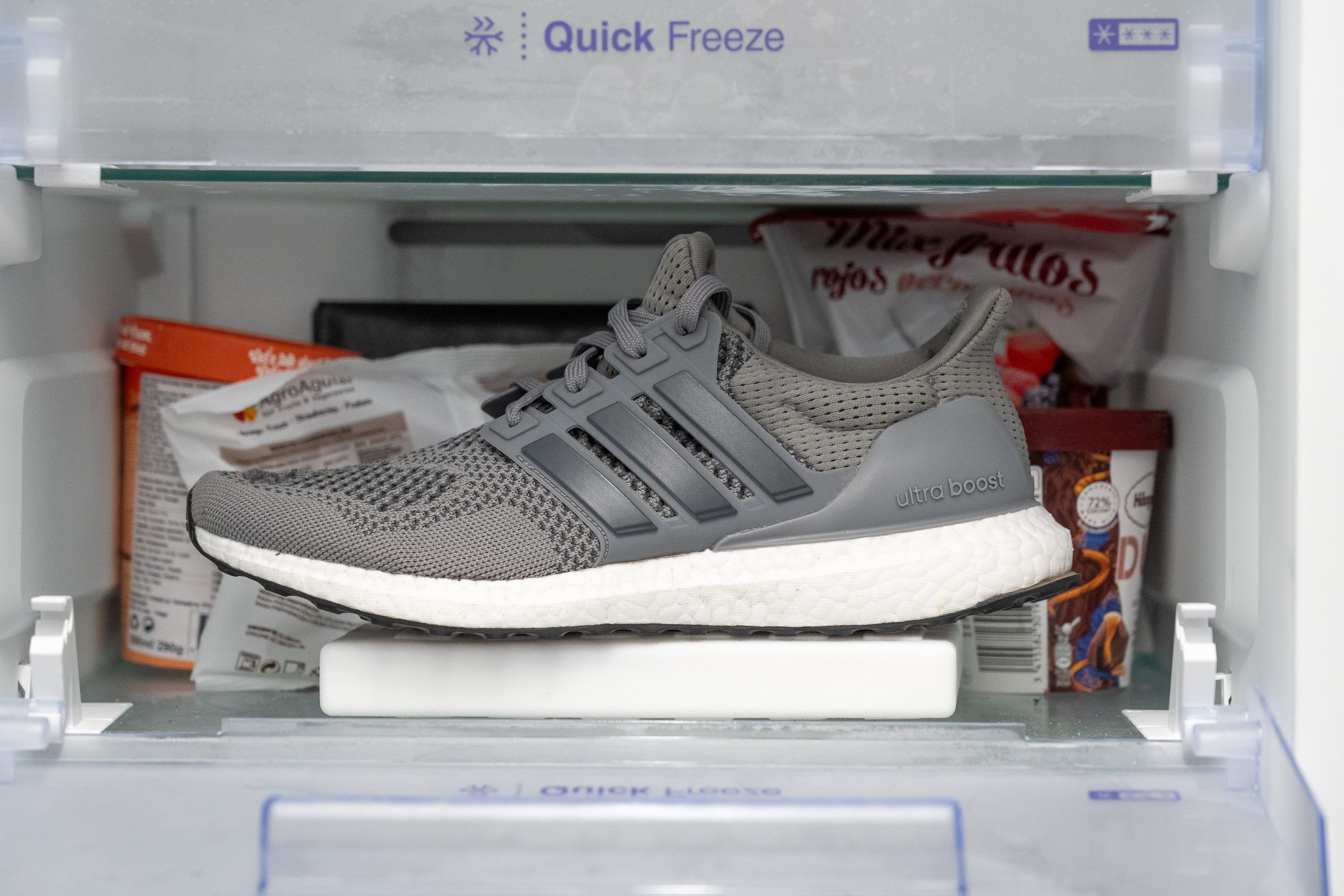
| Ultraboost 1.0 | 15% |
| Average | 24% |
Reflective elements
The Adidas Ultraboost doesn't come with any reflective bits. So, if you're a night owl and love those afterwork runs, this might not be the shoe for you. Lack of visibility features is a definite downside for us.
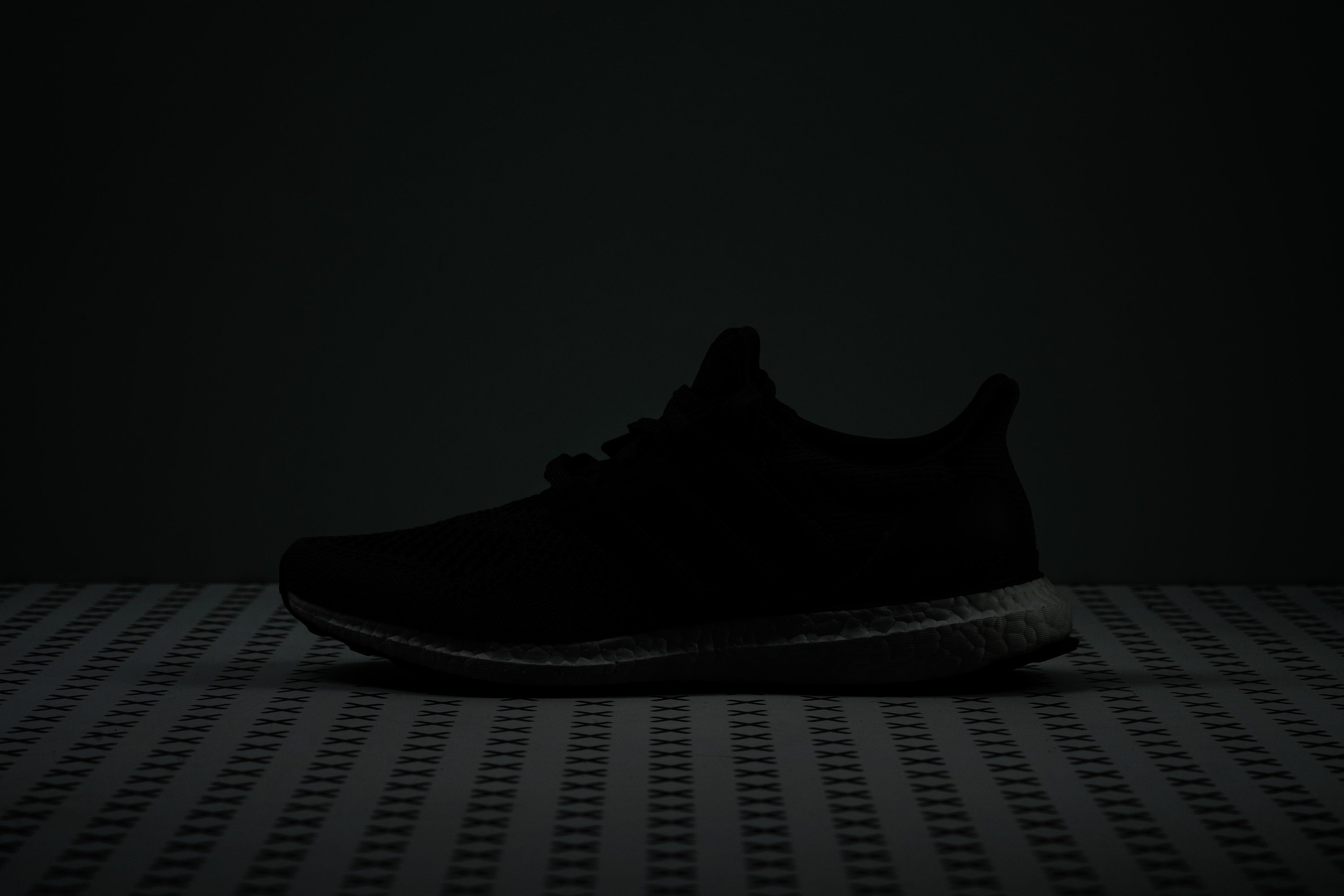
| Ultraboost 1.0 | No |
Tongue padding
When it comes to comfort, the Ultraboost pulls out all the stops thanks to its crazy-plush sock-like tongue.
At a thickness of 10.9 mm, it's practically double the average, and it provided a cloud-like feel for our instep. We just loved it!

| Ultraboost 1.0 | 10.9 mm |
| Average | 5.8 mm |
Tongue: gusset type
While not everyone loves this style of sock-like tongue, in the case of this shoe, it really hits the mark. We wouldn't want it any other way in a shoe named "Ultraboost".
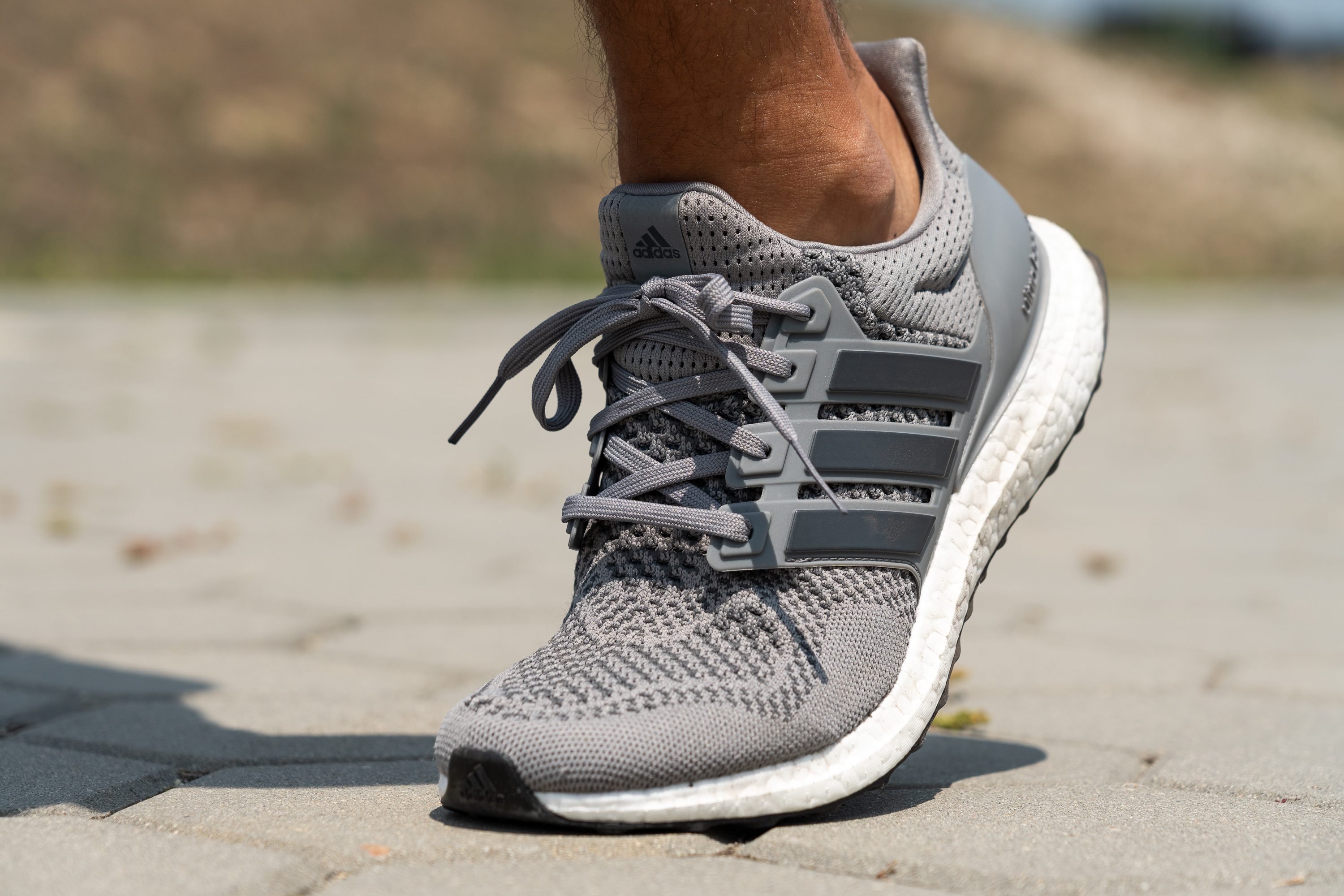
| Ultraboost 1.0 | Sock like |
Heel tab
The shoe's bootie-style upper can be tricky to slide into, but its extended heel collar comes in handy during the on-and-off action.
| Ultraboost 1.0 | Extended heel collar |













































